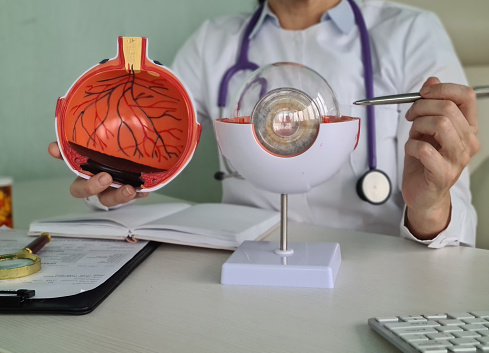Common Conditions that Affect the Cornea
Dry Eye
Many people suffer from a feeling of eye dryness, or “dry eye.” Symptoms range from an irritated eye in certain conditions to blurriness, redness, and foreign body sensation. These symptoms may only mildly interfere with one’s life or in some cases cause a severe disability. This irritation of the surface of the eye can have many different causes and is important for us to determine which ones apply to you. A variety of treatment options are available, the choice of which depends on the severity of the disease and what is seen on examination.
Learn More about Dry Eye
Inflammation and infection of the conjunctiva and cornea:
Inflammation may affect the conjunctiva, a highly specialized skin covering the front of the eye. It may be caused by allergies, reactions to chemicals, or infections. Infections may be caused by viruses, fungi, bacteria, or protozoa. If the infection affects the cornea, it may cause a corneal ulcer. Corneal infections are associated with redness, pain, light sensitivity, and reduced vision in the affected eye. Any infection in the cornea can lead to scar formation. Scarring can reduce the quality of vision, so prompt diagnosis and treatment of infections is critical. Risk factors for corneal infections include contact lens wear, injury, or eye trauma.
Fuchs’ Dystrophy
Fuchs’ dystrophy is a non-inflammatory, genetic corneal condition that may be progressive and may affect both eyes. The internal cell lining of the cornea called the endothelium, becomes damaged. If the endothelium does not function properly, fluid accumulates in the cornea, which causes clouding and a slow decrease in vision. Initially, patients will notice blurred vision in the morning and a glare or halos around lights. As the dystrophy progresses, one’s vision can be blurred all day long. Early Fuchs’ dystrophy can be treated with hypertonic saline drops to help remove excess fluid from the cornea. In more advanced cases, partial corneal transplantation (Endothelial Keratoplasty) to replace the damaged cells may be necessary to restore vision. Modern-day endothelial keratoplasty is highly successful and patients experience a faster recovery compared to previous transplantation methods previously available.
Keratoconus
Keratoconus is a common corneal condition in which the cornea begins to thin. As it thins, it loses strength, and aspects of the cornea start to bulge. The cornea changes into an abnormal shape, and one’s vision becomes affected. Initially, the vision can be corrected with glasses or contact lenses. As the disease progresses, there is loss of vision and corrective lenses may no longer be effective. It is recommended that patients with progressive keratoconus undergo early crosslinking treatment of the cornea to prevent the progression of their disease and permanent vision loss. This treatment is performed in the office and is the only FDA-approved treatment to halt the progression of keratoconus. Patients with severe untreated Keratoconus may need to undergo a full-thickness corneal transplant to restore good vision.
Learn More about Keratoconus
Corneal transplantation
In patients who have corneal disease affecting the endothelium (the innermost layer of the cornea), partial corneal transplantation can be offered to restore vision. Two types of partial thickness corneal transplants offered are Descement’s Membrane Endothelial Keratoplasty (DMEK) and Descemet’s Stripping Automated Endothelial Keratoplasty (DSAEK). In these procedures, a smaller amount of corneal tissue is transplanted, offering faster visual recovery for patients with corneal swelling caused by endothelial conditions such as Fuchs’ dystrophy and endothelial damage. Only a very thin layer of cornea is removed and then replaced with a thin layer of donor cornea. Patients who undergo partial corneal transplantation also have better visual potential and a lower risk of rejection when compared to full-thickness corneal transplants.
Learn More about Corneal Transplants
Get Help Today
If symptoms of corneal diseases are making you uncomfortable and interfering with your daily life, call us. Our doctors have the expertise and tools to give you the relief you need.
Schedule An Appointment Online


